The Voyager Sea Kayak
Voyager is derived from a basic UK design, and was developed, more as a technology demonstrator than a production boat, around three axioms:
- The kayak must be controllable in all conditions with the cockpit flooded
- Self rescue must be possible without the use of extra, redundant, equipment (i.e. paddle floats, etc.)
- The kayak must remain controllable with loose water in the hull compartment(s)
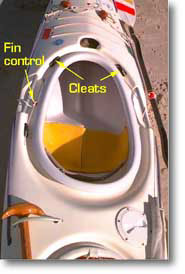
To meet those requirements requires a cockpit of minimum volume. The best way to achieve that is not with the bulkheads of conventional craft but with an integrated cockpit: seat and bulkhead in one piece, and sealed to the deck. The idea was devised by Alan Byde in the UK, and is also used in the Sea Tiger (UK), Puffin (Canada/New Zealand), kayaks by Aquadynamic Watercraft (Canada), and Star Kayaks (NZ). Voyager’s cockpit holds 80 litres, or 40 litres of water with someone in it.
The opening ahead of the cockpit is access to a ‘glovebox’ beneath the deck. On either side can be seen the hand-rails which give secure grip for re-entry and roll self rescue. Stowed on the aft deck are the single blade spare paddle and the sail rig in its tube. The two cleats are used for the mainsheet when sailing, or for the towline (which is stowed on the aft hatchcover).
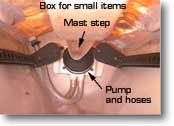
The standard pump in a Voyager has been the Whale Baby Foot Pump GP 4618 (a galley pump made by Munster Sims Engineering, Bangor, N Ireland). This small pump copes with the amount of water in a Voyager cockpit: standard cockpits require something bigger. Recent boats have used a modified Taiwanese hand pump: cheaper and greater capacity. (The manual pumps fitted to many other sea kayaks are useless when needed most. See What am I to do with all this water? for a discussion of this issue.)
Because there are no bulkheads, any water that enters the hull finds its own level amidships, without affecting trim. It cannot slosh (free surface), because of the cockpit and its support, and gear and buoyancy, so stability is not affected. In fact experiment and experience suggest that stability is actually improved as the water moves out of phase with waves, although the boat is naturally heavier. (This issue is discussed in A Flooding Experiment.)
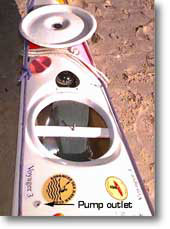
Hatchcovers are grp, with a bar beneath the hatch and secured by a large nut (the pink object on deck). Beneath the bar can be seen the buoyancy material always carried when the boat is ‘empty’. This view also shows the compass, protected in its well.
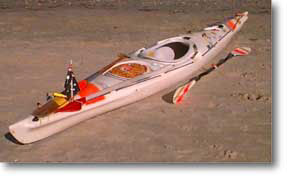
This view shows the spare paddle and sail rig stowed on the aft deck, and the towline on the aft hatchcover. Pronounced flare at bow and stern is modelled on the shapes of Aleut baidarkas. (By rights, that should be an Australian red ensign, but they are not made that size so it’s a blue one.)
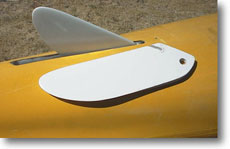
Voyager is without rudder. Instead, it uses a retractable fin to control its directional stability. Picture shows the fin in ‘full down’ position. The fin is 38 cm long and 11 cm wide, and the extra blade shows the pivot slot and the hole for the knots in the control and shock cords. The curve (lower right in the picture) is grooved to act as a ‘pulley’ for the cords.
The Voyager family
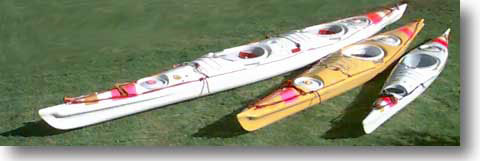
At right, the junior version, Voyager 2, 375 cm long, developed to answer the question whether there were few junior kayaks because few 10–12 year olds paddled, or whether few children paddled at sea because there were no boats for them. The question is still unresolved. The boat is a 7/10 scale version of the original Voyager (not shown) which was without the bow and stern flare.
Voyager 4, the double, is at left. It is 607 cm long. Not clear in this picture are the small hatches (dinghy inspection ports) immediately aft of the forward cockpit.
The boat in the centre is a Voyager 3, as described above.
(On odd numbered days Voyager is named after the 1970s planetary spacecraft, on even days, the Rutan Voyager aircraft.)
Please note that Voyager is not available commercially.
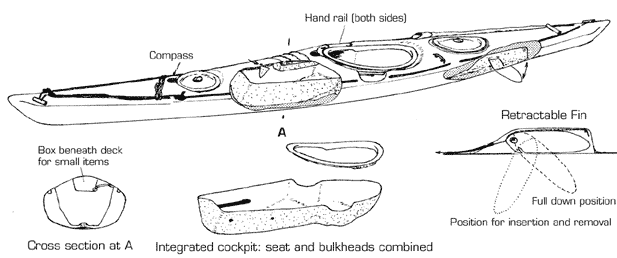
2006: the SOT
The latest Voyager (June 2006) is a one-off sit-on-top, built for easy hopping on andf off in mangrove backwaters. The hull is standard, the deck is flat aft of the forward hatch, and the cockpit includes an enclosed section beneath the knee position, accessible through a dinghy port. Cockpit draining was through a modified dinghy self-bailer, now replaced with a foot pump.
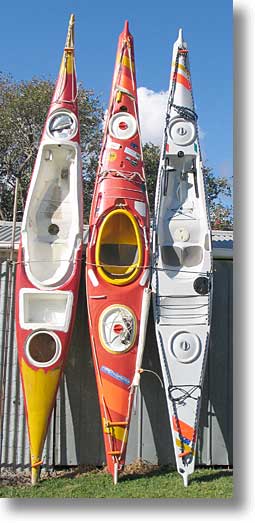
Boat on the left is the original Voyager plug, converted to SOT in the late 1980s, and used as an experimental ‘hack’, in the centre a recent Voyager 3, and at right the SOT. (Despite appearances, all boats are the same length)
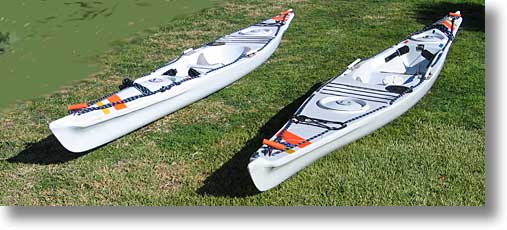
Two views of the SOT.